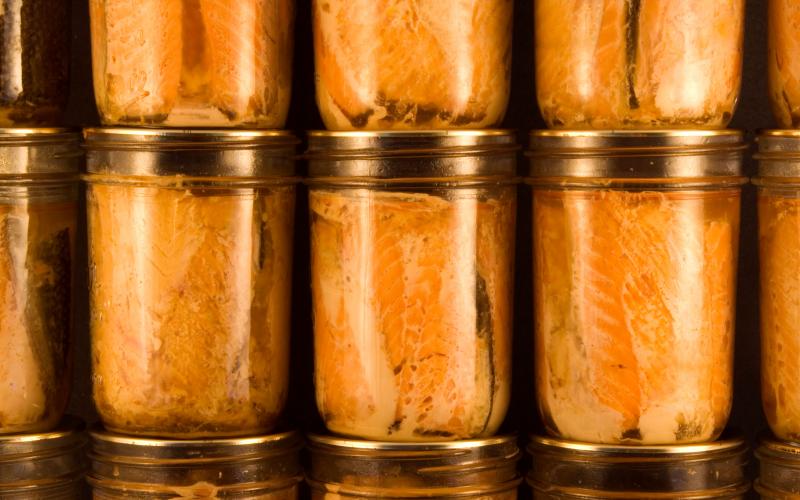Written collaboratively by Hope Kleine and Jake Elfmann.
Canning is a great method to preserve and extend shelf life for many types of foods, including meat products. Using safe preparation and storage practices allows for anyone to store nutritious, high-quality protein. It is important to practice safe food handling, storage, and preparation techniques because contaminated food will not be safe to eat following canning.
Preparation and Storage

Meats
For meats, such as beef, pork, venison, bear, lamb or veal, cut meat into strips, chunks, or pieces that are suitably sized for pint or quart jars. Whether you choose to store your meat using hot pack or raw pack methods, leave approximately 1 inch of headspace at the top of the jar. Finally, add a label and date to your storage container and then store in a cool, dark, dry place. Canned meat is best consumed within 18 months after processing.
Tips:
- Trim visible fat from wild game to avoid off-flavors.
- To reduce strong-flavored wild meats, age carcass at 40 F or less for 2-3 days and soak harvested meat for one hour in brine water containing 1 Tbsp of salt per quart of water. Rinse well.
- When canning leaner cuts of meat, such as venison, adding in animal fat, such as pork fat, aides in the preservation process, and adds flavor to the end product. Pork fat can be purchased from your local butcher for a minimal fee.
Poultry
For meats such as chicken, duck or goose, cut meat into strips, chunks, or pieces that are suitably sized for pint or quart jars. Whether you choose to store your meat using hot pack or raw pack methods, leave approximately 1 inch of headspace at the top of the jar. Finally, add a label and date to your storage container and then store in a cool, dark, dry place. Canned meat is best consumed within 18 months after processing.
Pressure Canning
When canning meats and poultry, it is important to use the right equipment. Only a pressure canner will reach the high temperature needed to kill the harmful bacteria in meat. Water bath canning methods, used to store high-acid or acidified foods, will not reach the required temperature and is not suitable for canning meat.
To learn more about safe pressure canning practices, watch our How to Use a Pressure Canner video!
| Beef, Pork, Venison, Bear, Lamb or Veal |
|
|
|
|---|---|---|---|
| Strips, chunks, or pieces of meat |
|
|
|
| Strips, chunks, or pieces of meat |
|
|
|
| Ground or chopped meat |
|
|
|
| Ground or chopped meat |
|
|
|
| Chicken, Goose, Duck |
|
|
|
|---|---|---|---|
| Poultry (without bones) |
|
|
|
| Poultry (without bones) |
|
|
|
| Poultry (with bones) |
|
|
|
| Poultry (with bones) |
|
|
|
Adjusting for Altitude
Altitude can affect how much time is required when canning foods. Anyone canning at 1,000 feet above sea level or higher will need to make adjustments when processing foods in order to safely preserve food. The altitude of South Dakota ranges from 1,200 feet to more than 6,000 feet above sea level, so it is important to understand how your local altitude level will affect your canning process. View a topographic map of South Dakota to determine your local altitude. Refer to the information below for how to adjust for altitude when using a pressure canner.
Dial gauge canner pressure at:
- 0 – 2,000 feet: 11 pounds
- 2,001 – 4,000 feet: 12 pounds
- 4,001 – 6,000 feet: 13 pounds
- 6,001 – 8,000 feet: 14 pounds
Weighted canner gauge pressure at:
- 0 – 1,000 feet: 10 pounds
- 1,000 fee and above: 15 pounds
Additional Information
For further information on canning meats, visit the National Center for Home Food Preservation or the SDSU Extension Food Preservation page.

